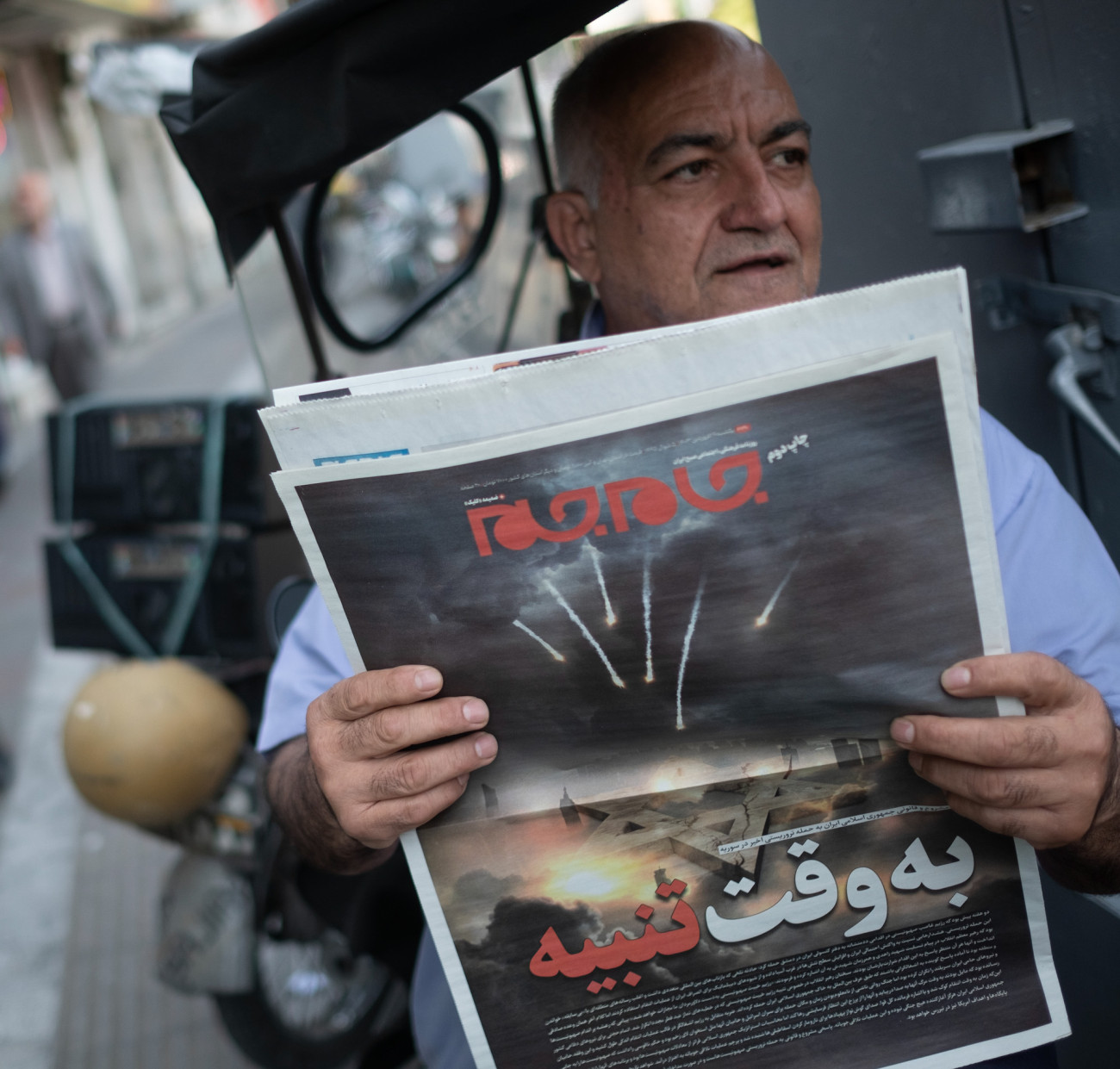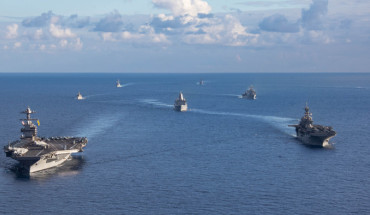

Introduction
The month of April saw a series of unprecedented escalations in the long-simmering Iranian-Israeli conflict, with both countries launching missile and drone attacks against the other’s territory for the first time in history.
In the wake of these strikes, what will be the impact on the regional security and political environment going forward, what is needed to stabilize the new rules of the game, and how can US diplomacy help to facilitate that process? MEI has asked its experts to weigh in.
Photo by Morteza Nikoubazl/NurPhoto via Getty Images
Viewpoints
-
Paul Salem
Paul Salem

Stabilizing de-escalation: Preventing another Iran-Israel state-to-state flareup
In the Hobbesian world of interstate relations, stability among foes is generally established through a balance of power, or at least a balance of deterrence. To some degree, this can be said to have been established over the last two weeks as Iran demonstrated the capacity and will to launch missiles and drones into Israel directly, and Israel demonstrated the same into Iran. The fact that most of Iran’s 300+ drones and missiles were shot down should not lead to false conclusions. Iran learned a lot about how Israel, the US, and regional allies would counter such a strike. If Tehran really wanted to cause widespread damage, it could send 3,000 or 10,000 such drones and missiles, or it could use Hezbollah’s arsenal, which is only minutes and not hours away from Israel. For its part, Israel demonstrated that it could reach into the heart of Iran — and the site of some of its key nuclear facilities — without alerting Iranian air defenses.
So, on the one hand, there is a new level of deterrence between the two sides. But, on the other hand, the dual attacks will also spur escalating concerns and threat perceptions in both countries. Israel now must take more seriously the fact that Iran is willing and able to strike it directly, as Iran must do as well. This is likely to lead to both an offensive and defensive arms race between the two countries. Israel is already getting a head start with the $17 billion military aid package approved in Washington this week, and Iran will likely go to Russia and China to greatly strengthen its air defenses and continue expanding its missile and drone arsenals. The risk that Iran might also move more decisively toward a nuclear weapons capacity to acquire the ultimate deterrence must be taken into consideration as well.
We are already in a new reality in the Middle East, and there is little that the US or others can do to fully turn back the clock to before April 13. But there is much that can be done to try to manage and reduce the risks in this new reality, including the following:
- Establish an effective mediating back channel that links — even indirectly — Israeli and Iranian security decision-makers. The US would need to be a key player in this channel, and there are multiple regional actors — like Oman, Qatar, and Turkey — that can maintain channels with the Iranians. This back channel should work on establishing new “rules of the game” or “red lines” to make sure the two regional powers don’t escalate directly again.
- Since this entire wave of regional escalation has been the result of the latest round of Palestinian-Israeli conflict, the US should redouble its efforts to find a final and sustainable end to the war in Gaza, facilitate the return of the remaining Israeli hostages, and work toward rapid improvements in human security and recovery for the people of Gaza. The US should also insist on a return to a pathway toward a two-state solution.
- The US and China should keep close tabs on their partners — Israel for the US, and Iran for China — to manage this dangerous conflict axis going forward and avoid a major conflagration.
Paul Salem is president and CEO of the Middle East Institute. He focuses on issues of political change, transition, and conflict as well as the regional and international relations of the Middle East.
-
Alex Vatanka
Alex Vatanka

It’s time for Tehran to take a cold, hard look at its proxy strategy
The recent blow-for-blow between Iran and Israel is bound to result in some introspection in Tehran, although this will not be immediately evident. For now, Iranian officials are seeking to show that the fusillade of drones and missiles the Islamic Republic fired at Israel on April 13 has reestablished mutual deterrence. This latest round of escalation was sparked by Israel’s airstrike on the Iranian embassy in Damascus on April 1, which killed several key commanders of the Islamic Revolutionary Guard Corps, and following Iran’s retaliatory strike on April 13, Israel opted to respond in a limited fashion on April 18.
Now that the gloves are off, Iran and Israel cannot go back to the era of “shadow war.” Each side has demonstrated that it can target the other’s sensitive sites with its military arsenal. Still, on the Iranian side, it is the first time since the launch of the “Axis of Resistance” some 20 years ago that Tehran has to choose whether it wants to center its entire national security strategy around the conflict with Israel.
Going forward, Tehran could choose to handle this conflict through political and diplomatic means rather than via the Axis of Resistance, a model of proxy warfare that has isolated Iran from the West and made its Arab neighbors deeply uneasy about its ultimate regional goals. After all, for Tehran, the fundamentals of the cost-benefit equation justifying the proxy warfare model have shifted considerably in recent weeks.
The proxy model was always meant to enable Iran to fight its regional rivals away from the Iranian homeland and at a relatively low financial cost. With the Iranian-Israeli rivalry having entered the stage of direct conflict, this is no longer possible.
Iran is not the first country to use proxies to advance its agenda. Over the last century, the US, the USSR/Russia, and China have all used proxies far more extensively in their pursuit of power. And yet each of these states would abandon a proxy if the costs exceeded the benefits. Moreover, the costs of engaging in a proxy war are never measured solely in commitment to an ideological cause but also in factors like overall geopolitical interests, financial expense, and general domestic support for a proxy strategy.
In the case of Iran today, its regional proxy model is as much a product of opportunities that arose in the last 20 years — when political unrest broke out and security vacuums emerged in places like Syria or Yemen — as it is a consummate alliance. The best example of this is Tehran’s fickle ties with the regime of Bashar al-Assad in Syria.
In fact, Assad’s latest maneuverings are the sort of realpolitik Tehran should learn from. The Syrian president is not only reportedly holding meetings with the Americans — which Tehran itself refuses to do — but he has also declined to join Tehran in its ideological fixation on Israel.
Media reports in Tehran suggest that elements within the Assad regime might even be passing intelligence on to the Israelis so they can target Iranian assets in Syria. Now that the Assad regime has survived the popular revolution, the Iranians are perhaps no longer needed. The validity of such reports aside, the point is that Assad’s loyalty is not a foregone conclusion for Tehran.
All this is to say that Iran has plenty of reasons to take a cold, hard look at the costs and benefits of a proxy war strategy against Israel and its American backers. The potential fallout has never been this great and the whole enterprise looks increasingly shaky, with some of Iran’s partners in the Axis of Resistance at best conditional allies pursuing their own agendas, while Iranian public opinion is squarely opposed to the regime’s perilous proxy war strategy.
Alex Vatanka is the director of the Iran Program at the Middle East Institute and a Senior Fellow with MEI’s Black Sea Program.
-
Nimrod Goren
Nimrod Goren

Amid new rules of engagement, Israel sees increased importance in alliances and partnerships
The fast-paced news cycle in the Middle East has quickly diverted Israeli public attention away from the April 13/14 Iranian attack that was viewed in real-time as an unprecedented and highly dangerous military threat. Following the Israeli retaliation that did not generate a further Iranian response, Israel’s focus has turned once again to Gaza, with preparations now underway for a possible operation in Rafah, and to the ongoing escalation with Hezbollah along the Israeli-Lebanese border.
But the rapid pace of events should not overshadow the game-changing nature of Iran’s decision to, for the first time ever, directly strike Israel. It was a development that may lead to new rules of engagement in the long-standing conflict between the two Middle East powers and could affect Israeli calculations about future military actions against Iranian targets.
Prior to Iran’s attack on Israeli territory, Israel publicly committed to retaliate in kind, and it seemingly did so. But the Israeli attack was a carefully measured response, geared toward preventing another escalation and Iranian retaliation. It was reportedly aimed at a military, air force-related target — not a civilian or a nuclear one — thus matching Iran’s targeting choice in its own attack against Israel, days earlier.
Israel notably refrained from publicly taking responsibility for the attack, although it provided multiple hints of its involvement in case anyone had doubts. This enabled the Iranian regime to deny an Israeli attack and downplay the whole event as a face-saving measure, legitimizing its lack of immediate response. Israel also put face-saving tactics into play, to justify its limited response to an attack by more than 300 drones, cruise missiles, and ballistic missiles: Messages from Israeli sources indicated that Israel planned to respond much more forcefully but toned down its response due to Western pressure.
Israel drew crucial lessons from the action to block the Iranian strike, which was overwhelmingly successful also thanks to joint support from the United States, Jordan, Saudi Arabia, France, and the United Kingdom. Israel traditionally highlights its self-reliance and freedom of military action as key principles of its national security doctrine, although in practice it is often dependent on American green lights and military support. Following the Iranian missile and drone attack, the need to coordinate actions with the US and to operate within the scope of action that the Americans were willing to accommodate became much more visible to the Israeli public.
The strategic importance of Israel’s peaceful — yet strained — relations with Jordan also came to the fore, refuting the repeated doubts voiced by Israeli right-wing politicians in recent years about the benefit of these ties. It also became evident that the strategic cooperation between Israel, Saudi Arabia, and the US that came into play to foil Houthi attacks since Oct. 7 encompasses other issues as well.
To successfully counter Iran in the future, Israel will need to further strengthen its regional partnerships. This can be best done in the context of a pathway toward an Israeli-Palestinian two-state solution. That will enable Israeli-Saudi normalization to take place as well as generate renewed momentum in Israel’s existing regional ties.
In the meantime, Israel and Iran are likely settle back into their traditional conflict mode. Iran’s proxies, especially Hezbollah, will continue to challenge Israel’s borders, and Israel will likely keep taking covert action against Iranian targets related to its nuclear program and trying to limit Iran’s presence in Syria. Israel will probably be pleased if the main takeaway from the April attacks is that striking Iranian targets sparks an Iranian response only when it is on Iranian territory (including its diplomatic missions abroad). That will be a reasonable rule of engagement for Israel to follow.
In their recent exchange, Israel and Iran showed that they can both act rationally and limit confrontation to the level they desire. In doing so, they utilized existing indirect diplomatic channels between the US and Iran (for example, via Swiss diplomats) that enabled them to convey these intended messages. Israel increasingly acknowledges the importance of multiparty mediation on different fronts, as is also evident in the ongoing talks to release the hostages held by Hamas. This is a positive development, which should be accompanied by Israeli efforts to invest in setting up Iran-related dialogue channels of its own.
Dr. Nimrod Goren is the Senior Fellow for Israeli Affairs at the Middle East Institute, President of Mitvim - The Israeli Institute for Regional Foreign Policies, and Co-Founder of Diplomeds - The Council for Mediterranean Diplomacy.
-
Brian Katulis
Brian Katulis

Increased US engagement, not withdrawal, is needed for Middle East stability
For many years, countries and non-state actors have tested the limits of their power in the precarious and uncertain balance of forces in today’s broader Middle East. The rise of the Islamic State in Iraq and Syria was one such example about a decade ago, prompting the United States and key regional partners to come together to thwart this strategic threat to the state system and global stability.
The open conflict between Israel and Iran that emerged from a decades-long shadow war over the past several weeks represents the latest episode of two important states openly testing the limits of their power. In the confusing din of competing political agendas, policy views, and propaganda and information warfare surrounding the exchange of missiles and drone attacks between the two sides, it could be easy to miss this elemental point: that Israel and Iran had challenged each other through terror attacks, assassinations, proxy warfare, and other mostly covert means for years, and now things were out in the open.
But even this low-grade open warfare between Israel and Iran was quite limited — the human and financial costs of these salvos were minimal, particularly compared to the civil wars that have raged for years elsewhere in the region, in places like Syria, Iraq, Yemen, Sudan, and Libya. The two countries wanted to send each other a message and test how the other would respond, but they both wanted to keep things from getting out of hand.
One other elemental point that was missed in the wave of commentary about this Israel-Iran game of chicken: the centrality of the United States in preventing a wider escalation in the region. Despite all the noise and the advocacy agendas being pushed from various ideological and partisan perspectives in America’s Middle East policy debate, the basic fact remains that the US military presence and some quiet crisis diplomacy were key ingredients incentivizing a certain degree of restraint by the two main parties, Israel and Iran. The United States has built a de facto and unspoken coalition across the region to respond not just to the Islamic State but also to the increased threats posed by Iran and its network of partners from the Houthis in Yemen to Lebanon’s Hezbollah, as well as militia and terror groups in Palestine, Iraq, and Syria. This military coalition shot down nearly all of the missiles and drones that Iran used to target Israel. And it was US diplomacy with Israel, in quiet coordination with Arab partners, that kept Israel’s response to Iran’s salvo within certain bounds.
What does this mean for the future? First, it means that the United States should continue to play its leadership role in seeking to advance strategic security integration among its partners in the region, while pragmatically recognizing the limits imposed by trust and confidence gaps. No other outside power — not China, Russia, or any European country — has the depth and breadth of relations across the region to offer protection against the regional and increasingly global security threats emanating from Iran and its network of partners.
Second, the United States should step up its diplomatic role in seeking to calm tensions across the region and using quiet diplomacy to help actors step back from the brink of a wider conflagration. This means working more closely in concert with its partners on efforts to pursue regional integration and advance toward the creation of a Palestinian state, something that most, but not all, of America’s partners in the Middle East currently support.
Lastly, the United States should sideline the voices inside its policy debate that have argued that America and its military and diplomatic presence in the Middle East are more of a hindrance than a help to regional stability. The events of the past several months have demonstrated that these views are disconnected from the reality of today’s Middle East, which stands to benefit from increased, more balanced, and steadier US engagement across the region.
Brian Katulis is Senior Fellow for US Foreign Policy at the Middle East Institute.
-
Charles Lister
Charles Lister

Red lines crossed, Iran and Israel now face a precarious, unpredictable environment
For decades, the hostility that defined the relationship between Iran and Israel has played out in the shadows — through espionage, in cyberspace, and by covert cells, allied proxies, and special forces operating behind enemy lines. Though unquestionably violent and often deadly, that shadow and mostly asymmetric war has sustained itself for years within a framework of undeclared red lines. That created a certain level of predictability and ensured that spirals of dangerous escalation remained off the table, or at least were highly unlikely.
That all changed this month, when long-standing red lines were methodically crossed, beginning on April 1, when Israel conducted a precision airstrike on a building annexed to Iran’s consulate in Damascus, killing the entire Islamic Revolutionary Guard Corps (IRGC) Quds Force leadership for the Levant, including Brig. Gen. Mohammad Reza Zahedi. Twelve days later, on April 13, the inevitable happened — Iran struck back, launching more than 300 suicide drones and ballistic and cruise missiles across the Middle East, at Israel. In a remarkable feat of international military coordination, the US, the UK, France, Israel, Jordan, and other regional actors intercepted virtually everything, effectively neutralizing what had otherwise been an unprecedented aerial assault. On April 18, Israel responded by launching several Blue Sparrow missiles into Iran from fighter jets flying in Iraqi airspace, targeting an IRGC radar site outside Isfahan that defends the Natanz nuclear site.
Though that relatively minimal strike was intended primarily as a demonstration of Israel’s reach and a warning not to escalate further, Iran retains cards to counter asymmetrically: its proxies. The unprecedentedly dangerous tit-for-tat between Israel and Iran in recent weeks has been direct state-on-state action, while Iran’s proxies have continued their previous activities unaffected. The one exception here is Iran’s militant partners in Iraq and Syria, which have held to an unspoken cessation of attacks on US forces since early February.
In the past, when Iran has felt particularly triggered by Israeli actions, it has used its proxies in Syria and Iraq to hit back — not against Israel itself but by targeting US troops as a source of indirect pressure on Israeli policy. That card may now be back in play, as Iran seeks to hit back for the Isfahan strike using asymmetric methods. On April 21 and 22, Iranian proxies conducted at least three attacks on US forces in Iraq and Syria — their first in more than 10 weeks.
That resumption is no coincidence; and while it may signal a return to the dynamic that governed hostilities prior to April 1, describing it as such would be unduly optimistic. Once red lines are crossed, they remain blurry at best. And from the perspective of states and proxies alike, the operating environment is now far more precarious and prone to intended or unintended escalation.
Charles Lister is a Senior Fellow and the Director of the Syria and Countering Terrorism & Extremism programs at the Middle East Institute.
-
Ross Harrison
Ross Harrison

Iran, Russia, China: A triple alliance under the strain of war
Plenty of ink has been spilled about a renewal of great power competition in the Middle East. But in the aftermath of the Hamas attacks of Oct. 7, 2023, Russia and China have seemingly ceded center stage to the United States, effectively counting on Washington’s ability and willingness to curb Israel’s appetite for revenge as well as to prevent a spillover of the conflict beyond Gaza. In the wake of Iran’s mid-April stand-off attack on Israel and the Israeli counterattack, however, it is important to understand what role Moscow and Beijing may play going forward in mitigating escalation between Iran and Israel.
There are several reasons why Russia and China appeared to be less regionally active than before Oct. 7. One is the reality that they had limited military and diplomatic wherewithal to deal with an intensifying fight in Gaza. Another is that Russia and China have less skin in the game in the Gaza war than the US, Israel’s key ally.
But there is also a more strategic explanation for Russia and China having cut lower profiles. Namely, both countries became free rider beneficiaries of US activity in the region since Oct. 7. For Russia, the Gaza war and the role American arms played in Israel’s bloody involvement took the international spotlight off Moscow’s brutality in Ukraine as well as opened Washington up to charges of a double standard. For China, there has similarly been less focus on Taiwan compared to six months ago. And Beijing has also benefited from US efforts to provide security in the critical shipping lanes of the Red Sea under attack by the Houthis. Moreover, both Russia and China politically gained from the drubbing US President Joe Biden got on the world stage and back home over what was seen as his offering unconditional support for Israel.
Yet on April 1, when Israel attacked the Iranian consulate in Damascus, everything changed. Since then, the conflict has morphed from a shadow war mainly involving Iran-supported militias to a direct conflict between Iran and Israel. China and Russia now have more at stake in the outcome; neither would benefit from an outbreak of large-scale war in the Middle East. Moscow realizes that a protracted war could destabilize President Bashar al-Assad’s hold on Syria, Russia’s key stronghold in the region. And Moscow and Beijing both lose if a major war destabilizes Iran, a key ally to both. They also both lose if Washington somehow comes out on top following such a conflagration.
But the similarities end there due to significant differences between Russia’s and China’s respective interests. Russia has little interest in diplomacy succeeding, as it enjoys the company of a shared pariah state in the form of a diplomatically isolated Iran. Plus, successful diplomacy that ends the Gaza war and quiets the Middle East could once again focus the international spotlight on Ukraine. Stability could also bring global oil prices down, something that would further squeeze an economy under sanctions. Finally, diplomacy could benefit Washington, something Moscow wants to avoid at almost any cost. In other words, while Russia doesn’t want all-out war in the Middle East, it nonetheless benefits from a simmering conflict and an absence of de-escalatory diplomacy.
In contrast, overall regional stability works to China’s advantage, and so it has a larger stake in diplomacy — as long as it is pursued according to Beijing’s preferences. First of all, China has an interest in protecting the rapprochement it brokered over a year ago between Saudi Arabia and Iran, an agreement that could be upended by widespread war. Also, a war-induced spike in oil prices could roil an already challenged Chinese economy. And finally, China has benefited economically and strategically from being able to do business with all actors in the region, something total war could preclude.
Both Russia and China want to avoid all-out war in the Middle East. But we should expect that China gains more from diplomacy than Russia. In a strange twist, both Israel and Russia have an interest in keeping the present conflict at a simmer, for the leaderships of both countries could face harsher realities when the music stops. China and the United States, in contrast, may have a shared interest in stability, albeit with different views of what that might look like. Rather than a competition for either a new Pax Americana or a Pax Sinica, Washington perhaps could work toward a common cause with Beijing in building a foundation for a more secure and stable Middle East, while limiting Moscow’s ability to play its traditional spoiler role.
Ross Harrison is a Senior Fellow and Book Series Editor at the Middle East Institute.
-
Randa Slim
Randa Slim

Escalations in the Iranian-Israeli conflict will complicate negotiations between Israel and Hamas
The trilateral mediation process headed by Qatar, Egypt, and the United States between Israel and Hamas has failed to date to produce a second humanitarian pause that could lead to a permanent cease-fire and the simultaneous release of Israeli hostages and Palestinian prisoners held in Israeli jails. Pressure by the US president on Israeli officials has pushed Israel to allow more humanitarian aid into the Gaza Strip — but even these expanded volumes are not nearly enough to avert famine. At the same time, there are reports Israel is in the midst of preparations for a ground invasion of Rafah, in southern Gaza — the last refuge left inside the territory for the more than 1 million Palestinians who fled the northern and central parts of the strip.
Although none of the parties to the talks have declared them dead, neither of the two conflicting parties, Israel and Hamas, has been willing to make the tough concessions needed to get to a deal. Each blames its opponent for obstruction, and the US administration has put its finger on the scale by blaming Hamas for being the major obstacle to reaching a breakthrough in negotiations. Meanwhile, the sharp escalation in the Iranian-Israeli conflict this month will only further complicate the prospects for a cease-fire deal on Gaza.
Even without taking into account the broader regional consequences of the recent Iranian and Israeli attacks against one another, it is fair to say that the Israel-Hamas mediation process is on hold and it will take significant changes in the Gaza conflict dynamics, either due to internal or external pressure or both, to substantially alter the calculi of the two main opponents about the value of reaching a deal. Leaders in Israel and Hamas, though not necessarily for the same reasons, still believe a deal will hurt their interests more than the status quo.
Both the Israeli prime minister and the Hamas leadership, particularly Hamas leaders who remain in Gaza, are fighting for political survival in the former case and for physical survival in the latter. They face existential decisions, meaning the costs of failure are high and consequences are not just theoretical. Whatever decisions they make at present will have irreversible consequences for their own personal future.
Pressure exercised by the Israeli electorate seeks to push the Israeli prime minister toward concessions that could secure a deal. Yet such a deal might spell the end of his political future. From the other side, Qatari and Egyptian officials have also been applying pressure on the Hamas leadership to come to an agreement. But meanwhile, Israel has not stopped its onslaught on Gaza and is now threatening a ground invasion of Rafah. For Hamas leaders, especially those remaining in the Gaza Strip, a deal is primarily aimed at their physical elimination and ending Hamas’ role in the governance of Palestinian affairs. Indeed, Israeli and US officials have been quite vocal about their interest in achieving these two aforementioned objectives.
While the trilateral mediation team has access and is accepted by the two combating sides, it is not trusted by either. Each member of the team brings its own agenda to the table, which makes negotiations among the mediators about the desired objectives of the talks challenging in their own right. Both conflicting sides also suffer from a trust deficit in their respective camps. Intra-Palestinian and intra-Israeli divisions hamper the ability of the leadership on each side to make tough decisions that are not necessarily going to be acceptable to all stakeholders in their respective camps. Among Palestinians, there is growing public opposition to Hamas, blaming the group for the pain and humiliation they are suffering. Similarly, there is increasing public opposition among Israelis to the Israeli prime minister for failing to bring the hostages home and for his bad management of the war and its political implications on Israel’s reputation abroad.
Adding to the complexity of these negotiations are the side conflicts that directly impact on the decision-making calculi of the leaders in the Israeli-Hamas conflict. The uptick in the Iranian-Israeli confrontation as well as the progressive escalation in the Hezbollah-Israeli border clashes, where past rules of the game that governed those conflicts have been upended, add another element of unpredictability to an already volatile situation. They distract attention away from the war in Gaza and make the decision by Israeli and Hamas leaders to get to a deal even more difficult. For the Israeli prime minister, adopting restraint on the Iranian-Israeli front reduces his margin of maneuver on concessions that could be made to Hamas, especially if he needs to preserve the support of his right-wing coalition members. A war in Lebanon might buy him political time; though, if past is prelude, previous Israeli wars in Lebanon usually ended with the Israeli prime minister discredited and eventually removed from office.
Iran’s decision to make its shadow war with Israel a direct one between them, Hezbollah’s declared policy of escalation with Israel, as well as the involvement of other members of the Iran-led resistance axis in support of Hamas also gives them and Tehran a seat at the decision-making table, further convoluting the already fractious decision-making process on both sides.
Multi-party, multi-issue negotiations usually take a long time to conclude with a deal acceptable to all sides. This is especially true if the negotiations are taking place in the midst of an active conflict that has claimed tens of thousands of civilian lives and injured many more, upended the lives of millions, and has, to date, involved six different military theaters. We should not expect a negotiated end to the war to come quickly or easily.
Randa Slim is the Director of the Conflict Resolution and Track II Dialogues Program at the Middle East Institute and a non-resident fellow at the Johns Hopkins University School of Advanced and International Studies (SAIS) Foreign Policy Institute.
-
Robert S. Ford
Robert S. Ford

Identifying the new “red lines”: Old lessons from Lebanon
One of the most dangerous moments in international politics happens when armed adversaries try to redraw their “red lines,” as we are now seeing with Iran and Israel. Each side aims to reestablish its deterrence against the other, but it is not difficult to overstep poorly understood red lines and slip into an unintended armed exchange that escalates. Thus, the first priority must be to sketch out where the two adversaries’ red lines lie. An example from several decades ago is illustrative on this point.
After the 1978 Israeli invasion of Lebanon, Israel and Syria reached a modus vivendi in the country: Syria did not deploy forces south of the Litani River, and the Israelis accepted the Syrian military deployment elsewhere in Lebanon as long as Damascus didn’t deploy anti-aircraft batteries that could interfere with Israeli reconnaissance flights. The Syrians accepted that Israel sought to stop attacks along its northern border, while the Israelis accepted Syrian worries about instability in Lebanon spreading to Syria. Each side respected the other’s security interest or at least decided that the effort to eject the other would be too costly. These rules of the game lasted until the Israeli government perceived a strategic opportunity and invaded Lebanon in 1982.
Fast forwarding to 2024, Israel and Iran similarly need to understand the other’s redrawn red lines. Diplomatic action by concerned third parties, including the United States, can help the adversaries achieve this understanding and relay warnings. In the case of Iran and Israel, which do not maintain direct relations, other governments will have to be the message carriers and potentially brokers for the newly defined rules. But to be effective in this, Washington has to understand the difference between being a message carrier and being a broker. Washington could content itself with relaying messages to Israel from states speaking with Tehran that do not themselves have constant communications with Israel (like Oman and Qatar). However, if Washington wants to mediate to make the rules of the game stick — and reduce pressure for it to intervene against Iran down the road — then it must be ready to alter Israel’s perception of its national interests when it tests Iranian red lines.
The Reagan administration’s failure to press Israeli Prime Minister Menachem Begin and Defense Minister Ariel Sharon not to invade Lebanon in 1982 helped Israel decide to overturn the modus vivendi. Trying to contain the subsequent crisis, President Ronald Reagan personally demanded, four months later, that Begin exercise restraint amidst his August 1982 bombardment of Beirut. Israel acquiesced and the halt enabled US envoy Philip Habib to move ahead with a disengagement plan for Lebanon. On the other side, pressure from Washington and other capitals now must encourage Iran to respect Israeli red lines. Iran also will have to demonstrate that its proxies in Iraq, Syria, and especially Hezbollah in Lebanon will respect Israeli red lines. A particularly urgent issue is the Hezbollah attacks on communities in northern Israel, whose residents have had to evacuate. Washington’s successful brokering of the rules of the game between Israel and Iran will demand not only using leverage but also require staying power. Habib’s Lebanon plan later collapsed when Washington sought to reduce its engagement. Sustaining the Biden administration’s staying power on Israel-Iran will be hard given the many priorities in Washington in 2024.
Amb. (ret.) Robert S. Ford is a Senior Fellow at the Middle East Institute, where he writes about developments in the Levant and North Africa.











